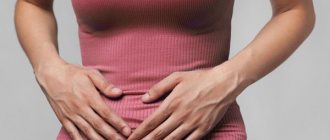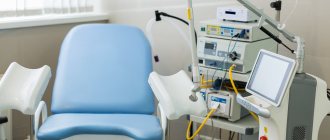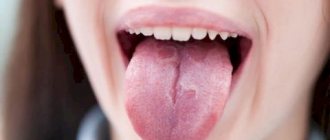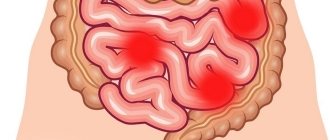Vaginal candidiasis (better known by its popular name - thrush) is a disease that affects a large number of women. Despite the disease being sufficiently studied, the chronic form of thrush in women is often observed.
Thrush occurs due to an imbalance of microflora in a woman’s vagina, and the causative agent of this disease is the yeast fungus Candida albicans, which belongs to the opportunistic microflora.
Thrush can also affect other parts of the body: the mucous membrane of the mouth, skin and even nails. But the most common is vaginal candidiasis. The fact is that the female vagina, by its nature, is not a sterile environment and serves as a habitat for many microorganisms that maintain normal microflora in a woman’s body. The fungus Candida albicans, the causative agent of vaginal candidiasis, is normally present in the vagina of every woman and maintains its pH balance along with other microorganisms. Under unfavorable conditions, fungi actively multiply, and thrush in women is accompanied by unpleasant symptoms.
This disease also occurs in men, but due to the anatomical features of the structure of the genital organs, female thrush is a more common occurrence.
Risks of getting sick
Candida mushrooms are natural inhabitants of the microflora of the human body. Therefore, there is always a chance of contracting thrush. However, due to physiological characteristics, women are at greater risk of developing candidiasis than men. Above you can see the symptoms of vaginal thrush in women.
Thrush during pregnancy
The development of vaginal candidiasis during pregnancy is dangerous for the expectant mother and the fetus. There is an increasing threat of the development of inflammatory processes during pregnancy, postpartum complications, and infection of the fetus, which can lead to fungal infection of its organs and even death. It is possible that the baby may become infected during childbirth. Treatment of thrush in pregnant women is complicated by the ban on taking antifungal drugs orally. Local treatment with vaginal tablets and suppositories is acceptable (Pimafucin is considered the safest among them during pregnancy). All the more important is the observance of personal hygiene rules, as well as protection from stress, proper nutrition with sufficient vitamins, walks, healthy sleep, which help strengthen the natural immune defense. If signs of thrush appear in a pregnant woman, she should immediately contact an obstetrician-gynecologist in order to carry out timely, adequate treatment and avoid complications.
For diagnosis and successful treatment of vaginal candidiasis, come to the Clinical Hospital on Yauza. You can see
prices for services Make an appointment
Symptoms
Clinically, depending on the location of the lesion, candidiasis can occur in the form of inflammation:
- tongue - glossitis;
- corners of the mouth - angulitis;
- mucous and red border of the lips - cheilitis.
The first symptoms of the disease are the appearance of pain when eating, discomfort, burning and dry mouth. Then, first redness and then a white cheesy coating forms on the oral mucosa.
- Acute thrush.
Lasts no more than 2 months, chronic - more than 2 months. The most common form is acute pseudomembranous candidiasis. Clinically, it is characterized by the appearance of pinpoint plaque on the mucous membrane of the cheeks and tongue (glossitis); after scraping off the plaque, redness and swelling of the mucous membrane remain underneath.
- Acute atrophic candidiasis.
Accompanied by complaints of pain when chewing, swallowing and talking, dry mouth, changes in taste. In this case, dry, atrophic mucosa is determined, plaque accumulates in the folds and is difficult to remove.
- Chronic hyperplastic candidiasis.
Most often it occurs in smokers; it may become malignant. In this case, a white coating in the form of plaques is observed, which is located on the hyperemic mucosa. Patients complain of dryness and burning in the mouth, changes in taste, pain when eating and talking.
- Chronic atrophic candidiasis.
It develops in the presence of prosthetic structures that put pressure on and injure the mucous membrane. There is practically no plaque; the prosthesis bed exhibits dryness, atrophy and soreness.
How to treat oral candidiasis?
Treatment is carried out using local and general, specific and symptomatic remedies. Among the main goals of therapy are the elimination of foci of infection in the oral cavity (sanitation), treatment of diseases that accompany candidiasis and are risk factors, and stimulation of the body's defenses. The total duration of treatment is usually at least 7-10 days.
As a means of local therapy, rinses are used - using solutions of boric acid, soda, sodium tetraborate. For a longer and more effective effect, such products can be used in the form of applications - moistening a cotton swab or bandage with the solution.
Nystatin for oral candidiasis is used to combat the main cause of the disease - a fungal infection. Treatment of candidiasis in the mouth may also include the use of other antimycotic (antifungal) drugs - for example, levorin ointment. The best effect is achieved by using several drugs, alternating them for several days.
Antifungal drugs are also prescribed for systemic therapy - in this case, medications for oral candidiasis and other infections such as Lamisil, Diflucan, Levarin, Nizoral, etc. are taken orally. In the most severe cases of the disease, the treatment regimen includes taking immunomodulatory drugs, as well as the use other agents that have a stimulating effect on the immune system and help strengthen the body’s own defenses.
An equally important task is to protect against additional fungal and bacterial infections that can join the Candida infection and complicate the course of the disease. For this purpose, rinses with antiseptic solutions - fucorcin, iodinol and others.
As an alternative, you can use ASEPTA antiseptic mouth rinse, which contains the active ingredients chlorhexidine and benzydamine. Both of these substances have broad antimicrobial effects. Regular use of ASEPTA rinses also has a pronounced anti-inflammatory effect and helps not only eliminate unpleasant symptoms, but also reduce the risk of complications.
Will folk remedies help?
Folk remedies for candidiasis can only provide temporary relief; they cannot fight the causes of the disease. Traditional methods should be used exclusively as auxiliary and only on the recommendation of a doctor.
For vaginal candidiasis, you can wash yourself with a weak soda solution, water with the addition of tea tree oil, eucalyptus, or chamomile decoction (douching is not recommended, especially for expectant mothers). You can use the same products to rinse your mouth if candida has become active in it, or wipe the skin affected by the fungus. For intestinal candidiasis, you can drink a decoction of wormwood root or tincture of juniper fruits.
Treatment of candidiasis in women
The treatment regimen for candidiasis in women is always individual and depends on the degree of neglect of the fungal infection, the state of the immune system and test results. It is possible to repeat the treatment course, in combination with antibacterial and antiprotozoal drugs for combined infections.
Preparations for the treatment of candidiasis in women at home:
- Natamycin (Pimafucin) is No. 1 for pregnant women with thrush.
- Nystatin (tablets, vaginal suppositories) has fairly low antifungal activity. Included in combined local remedies (for example, Terzhinan), suitable for combined fungal/bacterial infections.
- Miconazole (combined drug Klion-D) is a fast-acting drug (recovery in 1 week), used for candidiasis, bacterial vaginosis, trichomoniasis.
- Clotrimazole - for topical use (ointment, suppositories, vaginal tablets). Use at the very beginning of the disease or in combination with oral medications is recommended. Treatment course - 2-4 weeks.
- Fluconazole (Mikosist) - one 150 mg tablet is sufficient for acute manifestations. For prolonged candidiasis, take three times a week.
- Ketoconazole is an effective new generation remedy (ointment, tablets). Treatment of the acute form is 5 days, chronic - 10 days.
Local treatment with home remedies may also include:
- Douching with soda is effective with antifungal therapy, but the duration of use is limited to 7 days (dries out the mucous membrane);
- Decoctions of medicinal herbs with an anti-inflammatory effect (chamomile, sage), when used judiciously (no more than a week), will speed up recovery, but are not a panacea for thrush.
During treatment, abstinence from sexual intercourse is required. If a partner has symptoms of a fungal infection, mutual treatment is necessary.
Diagnostics
To make an accurate diagnosis, a combination of several methods is used - from a simple examination and questioning of the patient for complaints to laboratory methods, such as culture, microscopic examination of biomaterial, analysis of the degree of contamination of the oral cavity with fungal mycelium.
Oral candidiasis is accompanied by a number of characteristic external signs, in particular the formation of plaque, bad breath, ulceration and hyperemia of the mucous membranes. However, laboratory methods make it possible to accurately determine the type of pathogen and exclude the possibility of a secondary infection, which may affect the nature and duration of treatment.
Differential diagnosis is used to separate cases of candidiasis from aphthous stomatitis, leukoplakia, lichen ruber, streptococcal infection and other infectious pathologies of the oral cavity.
Causes of oral candidiasis
The main reason for the occurrence is a decrease in immune status, as a result of which the uncontrolled proliferation of microflora begins. Reduced immunity is observed in older people and infants, in patients suffering from HIV, AIDS and other diseases associated with immunodeficiency, in those who regularly expose the body to excessive stress, neglect the rules of a healthy diet and violate work and rest patterns. Risk factors include reasons such as:
- Use of medications.
Taking antibiotics, immunosuppressants (drugs that suppress the immune system) and some other medications leads to disruption of the immune system and the natural balance of microflora in the body. Oral contraceptives, which affect hormonal levels, have a similar effect. - Pregnancy.
During pregnancy, a sharp and significant change in hormonal levels occurs, which can lead to a surge in the activity of pathogenic and opportunistic microflora. - Radiation and chemotherapy.
Often occurs in patients undergoing drug and radiological treatment for cancer. - Injuries to mucous membranes.
Violation of the integrity of the mucous membranes leads to loss or deterioration of the barrier function, as a result of which the fungus enters deep into the tissues, causing inflammation and other symptoms. Small, but constantly recurring injuries are especially dangerous - for example, when wearing incorrectly fitted dentures or braces. - Overwork and stress.
Prolonged stress of physical and mental forces leads to a deterioration in the protective function of the body. Similar consequences are caused by hypothermia or overheating, regular lack of sleep, insufficient, excessive or simply unbalanced nutrition, abuse of alcohol, nicotine, and narcotic substances. - Hypo- and vitamin deficiency.
May be caused by a lack of nutrients, in particular vitamins B and C. - Somatic diseases.
Frequent companions of candidiasis include tuberculosis, dysbacteriosis and other pathologies of the gastrointestinal tract, diseases of the adrenal glands and other endocrine glands. Candidiasis is a contagious disease. A large number of pathogenic microorganisms are transmitted through kissing and sexual contact, through the use of shared dishes, towels and other household items. Infection can also occur during childbirth (vertical transmission from mother to fetus). In addition, there is a risk of infection through contact with infected pets.










